The Nirmita Composers Workshop founded by Dr. Chinary UNG, a Cambodian-American composer and professor of composition based in California. Dr. UNG was born in the province of Takeo, and studied music in the United States where he completed his PhD at Columbia University. He is the first Cambodian and American to win the Grawemeyer Award, considered by many to be the Nobel Prize in Composition. He has a long and fruitful career marked by many commissions and awards such as the Kennedy Center Friedheim Award, a Guggenheim Foundation Award and The National Endowment for the Arts Award.
During the Khmers Rouges, Dr. Ung took a decade off to search for his family during the Genocide and work on preserving the remnants of Cambodian music which has been severely affected by the Genocide. The idea of a composition workshop started with the thought that “ a country cannot move forward without creativity”. For several years, with his wife Susan, Dr. UNG worked on creating the workshop, seeking the advice of other professionals and doing several trials. This year marks the pilot edition of the Nirmita Composers Workshop in Cambodia. The workshop targets composers from South East Asia, and its mission is to foster creativity amongst younger generations of musicians. It gives the opportunity for students and faculty to learn about traditional Asian instruments and how to write for them, as well as having their pieces performed, recorded, and criticized. This year’s two-week workshop took place in Siem Reap, in Northern Cambodia where the Angkor Temples are located. It is significant for the workshop to take place around a place surrounded by history and considered to the cradle of the Khmer civilization. Not only does the history inspire those who are part of the workshop, it shows the ability for South East Asia to create new state-of-the-art music and still respect and be aware of your own heritage. In future years, the workshop will likely rotate between countries of the Mekong area or each country will have its own version of it.
I was invited to attend the Nirmita Composers Workshop as a composition fellow by Dr. UNG, and served as faculty liaison. I flew to Los Angeles first to meet my sponsor, Mrs. Jenny Lau, who has kindly made my trip to Cambodia possible. Mrs. Lau is also Cambodian and is currently finishing her book on her family’s survival during the Khmers Rouges. She is very passionate about helping the Arts and I’m very thankful to have met such a wonderful and generous woman. The next day, I began the long flight from Los Angeles to Taipei to Phnom Penh. We stopped one night in Phnom Penh before taking the bus the Siem Reap. I was gradually joined along the way by Dr. Ung, some of the faculty and the other composition fellow of the workshop, graduate student at the University of Oregon, Michael Fleming. For two days, faculty prepared for the workshop and we had the chance to visit the temples of Angkor. We welcomed the students on July 16, from our own country but also from Laos and Myanmar:
The workshop started out with an opening ceremony at Wat Bo in Siem Reap where we had blessings from the pagoda’s monk and were treated by a performance organized by the Cambodian Living Arts Association (CLA), one of our organizing partners in the workshop. The performance included three acts, one by a mohori ensemble, a pinpeat ensemble and a re-enacted scene of Angkorian Music with instruments created/inspired by the fresques at Angkor Wat. That afternoon, the workshop started.

Angkorian music re-enacted (photo: Chen-Hui Jen)
 Pinpeat songs depict various aspects of daily life in Cambodia such as working in the fields or heartbreak. The ensemble is small and composed of instrumentalists who play instruments that vary in timbre but are usually quiet, to not overpower the singers. (photo: Chen-Hui Jen)
Pinpeat songs depict various aspects of daily life in Cambodia such as working in the fields or heartbreak. The ensemble is small and composed of instrumentalists who play instruments that vary in timbre but are usually quiet, to not overpower the singers. (photo: Chen-Hui Jen)

Composed mainly of wind and percussion, the Pinpeat Ensemble accompanies court dances, masked plays, shadow plays, and religious ceremonies. (photo: Chen-Hui Jen)
The Nirmita Composers Workshop ran two divisions in the morning, one for Western Music Musicians and one for Traditional Cambodian Music. The reason why is that in Cambodia, traditional music is transmitted orally, whereas musicians trained in the Western traditions (myself, and students from US, Royal University of Fine Art in Phnom Penh, Laos and Myanmar) are taught to notate music. The process of composing music is different for these musicians because of the difference in set of skills and music genre. The Western portion of workshop focused on strengthening notation skills and presentation of scores, as well as rehearsals of our student composition. Afternoons classes varied. During our first first week afternoons were dominated by lectures by our faculty on how to write for western instruments (string quartet, piano and voice) and Cambodian traditional instruments, and critique of student works whereas the second week was dedicated to rehearsing our pieces and feedback from faculty and a lecture by composer Dr. Koji Nakano, who is an alumni from NEC !
The composition faculty presented new music is an all-new music concert at one of the ballrooms in the hotel in which the workshop took place. The music happening at Nirmita ranged from one spectrum to another, from traditional Cambodian compositions to compositions that encapsulated several trends in music. Our residing scholar, Australian musicologist and composer Dr. Corrina Bonshek had the chance to write a trio for roneat ek (khmer xylophone, IP Theary), pek pok ( a type of flute, YIM Chanthy) and viola (Susan Ung). Dr. Koji Nakano’s solo flute piece used extensive technique, his music being a blend of his training in the western world, his japanese heritage and inspired by his extensive traveling and residencies around the world. Sean Heim’s Dr. Ung’s pieces were significant, for he represents Cambodian excellence in the field of the Classical Music. The concert was surprisingly well attended and though they may have been a few laughs and ooh-ahhs here and there, the audience was respectful and well behaved. The reason why I am pointing this out is - this is Cambodia. You don’t get classical and even less so new music performances, and the fact that our young audience was genuinely interested and open to new music, showed that they knew they were witnessing something different, from another culture: if one doesn’t want their culture to be made fun of, one does not make fun of another’s culture.
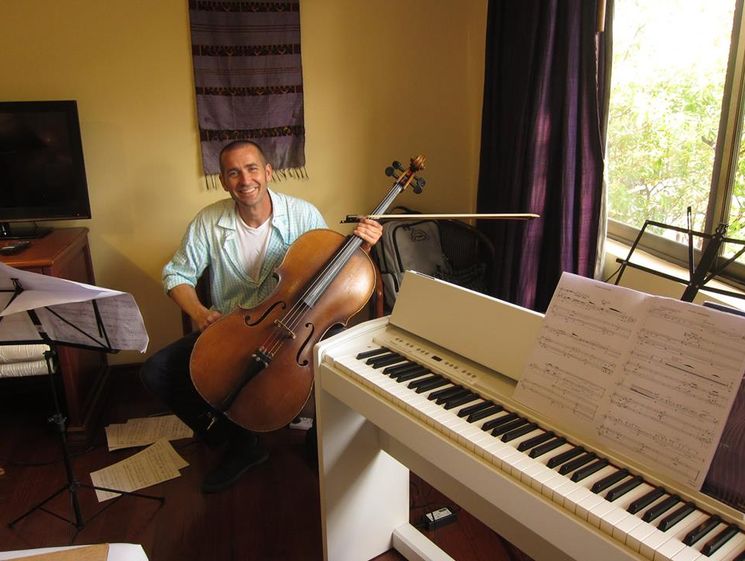
cellist Peter Jacobson (photo: Chen-Hui Jen)

our lecture room took place in one of the hotel's meeting rooms (photo: Chen-Hui Jen)
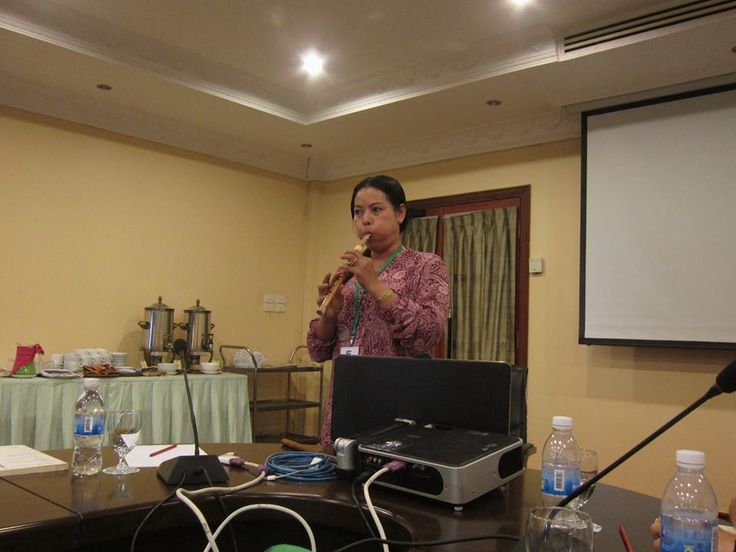
YIM Chanthy demonstrates the Pey Pok, she plays all Cambodian wind instruments fluently (photo: Chen-Hui Jen)

faculty and musicians after the new music concert (photo: Chen-Hui Jen)
While most students were tending more towards tonality, two stood out amongst for their non-tonal compositions: HONG Sreysantepheap “ Peace” for his piece “ Milky Way” (piano, violin, cello, oboe) and Michael Fleming for his piano quintet “ Padumasara - I. Dawn of petals’ glistening”. Others, were tending more towards tonality. Wai Hin Ko Ko, from Myanmar, wrote a flute quartet “Life” inspired by the music of his country and Church music. Anousone Pranikay, who had never composed before, wrote a beautiful string quartet inspired by Hmong music ( as half-Lao, I was very moved by it). Sros Som Piseth’s “ three little birds” quoted the popular children’s tune “ Sarika Keo” and hints of Mozart. CHEK Samnang wrote a piece for pinpeat ensemble and performed in the ensemble on his instrument, the Cambodian monochord Khsaè Diev. In my case, I wrote a trio for piano, flute and english horn. These compositions were presented at the end of the workshop in front of a panel of other composers who joined us our second week from Thailand, Vietnam, Japan, Australia and the Dean of the Royal University of Fine Arts.

presenting my trio (photo: Chen-Hui Jen)

students look over score during rehearsal (photo: Chen-Hui Jen)
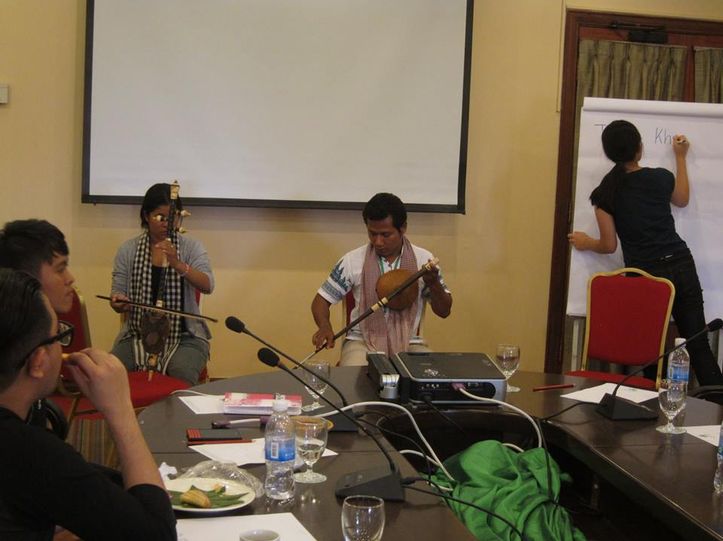
CHEK Samnang " Sinat" presents us his instrument, the Khsae Diev. Sinat also plays eight other Cambodian instruments.

Sinat was kind enough to teach me how the Khsae Diev works
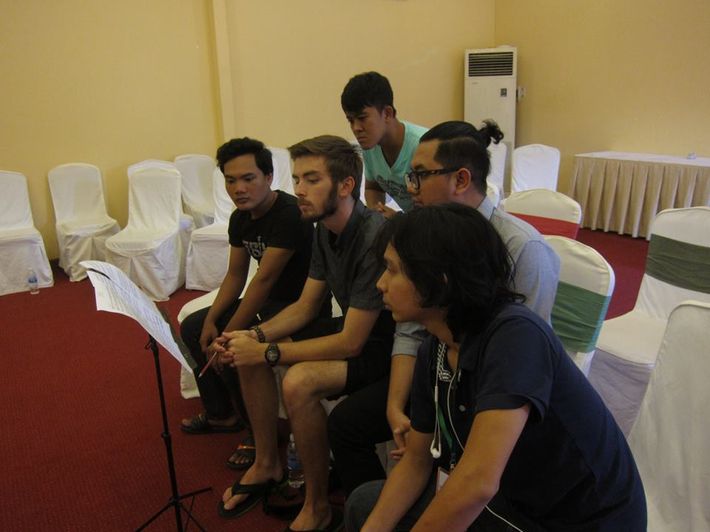
Un Sopheara, Michael, Ven Phath Malina, Peace, and Piseth in the back
What I liked the most about the Nirmita composers workshop was the opportunity to come back to Cambodia and be able to work with both artists from home and artists that are similar to those I have been working with in the United States. The schools of teaching are different. While students and mentors who studied abroad are exposed to several genres of music and teachers from different backgrounds, most of the students in Cambodia do not have this opportunity unless they travel abroad or are involved in programs like Nirmita because of the small amount of faculty at the Royal University of Fine Arts (RUFA), the only music program in Cambodia. However, this did not have any impact over the openness of every individual involved in the program and everyone was very considerate of each other’s personal narrative.
Another nice thing about the program is the proximity of students and faculty. We all lived in the same hotel, and when we were not rehearsing or lecturing, we shared meals together, swam at the pool or went out to enjoy the city of Siem Reap and temples of Angkor. One memorable moment was waking up to see the sunrise at Angkor Wat with Peace, Malina and Michael on our last day at the workshop. We drove off in Malina’s car at 5am and drove like crazies on the road to Angkor Wat. If you think Boston drivers are awful, boy … you don’t know Cambodians. Laws and regulations are bendy. While I do not condone corruption and risky behaviors, I do enjoy fun and the thrill of zigzagging between tuk-tuks and waving at the lady riding the motorcycle filled with vegetables giving us a crazed look.

Michael, myself, Peace and Malina at Angkor Wat
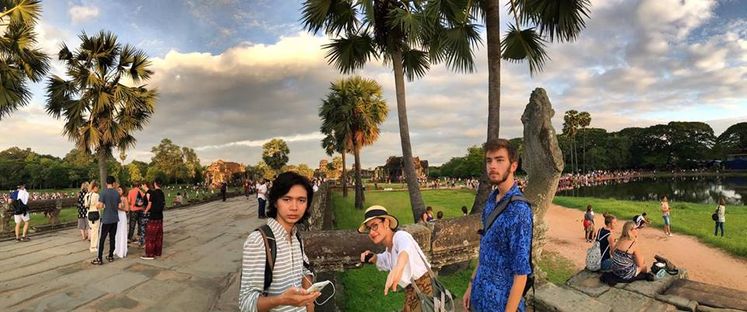
striking a pose at Angkor Wat (photo: VEN PHATH Malina)

at our closing dinner, each faculty and student was recognized for their individual work. Here Michael and I were thanked for our works at the Institute's Fellows

students proudly show their diplomas
While short compared to more famous music program, Nirmita was transformative for me. I was able to come back to Cambodia and suddenly see my culture from a different eye, having matured both academically and emotionally. I made new friends, and discussed with Dr. UNG about my academic career and what lies ahead. In my next blog, I will be writing about the social work I did in Cambodia and how it is living in the eye of the Cambodian media. Stay tuned!

Dr. Chinary UNG, myself, dance master EM Theay
